Congratulations to Patricia and Debbie who correctly identified last week’s “What Is It!” as witch hazel (American or common witch hazel, depending on whom you ask).
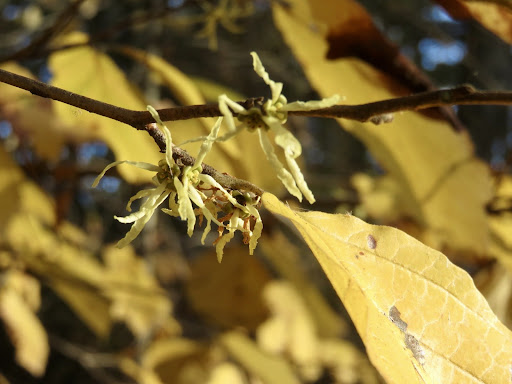
The flowering branch in my image belongs to a large shrub with arching stems, one that can grow 20 feet or higher. While this plant meets the textbook definition of a shrub, that is, “a woody plant with several stems growing from the base,” it feels like a small tree – at least the old specimens that I encounter. Such plants remind me of umbrellas, not only for their shape, but also for their height and habit. As I walk through a witch hazel grove, the branches form a sheltering subcanopy above my head. They are just the right height.

This understory species, which is native to the eastern United States and Canada, is common in Massachusetts forests. It prefers moist woods and floodplains. My recent sightings include the steep banks of a small river, the forest surrounding a lake, the floodplain of a stream, and the edge of a cranberry bog.
Witch hazel’s scalloped leaves are somewhat asymmetrical. In autumn, they contribute a lovely gold to our local woodlands.
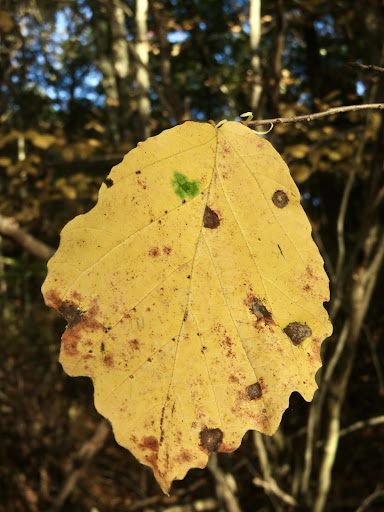
Of all its attractions, the witch hazel’s flowers command the most attention for their form and their timing. It is, as the author of Illinois Wildflowers declares, “the last woody plant to bloom during the fall.” In Massachusetts, the season begins in October and can continue into December.
Growing along the stems, each yellow flower has four ribbon-like petals and a four-part calyx composed of sepals. The blossoms are described as fragrant, though my nose hasn’t made the connection.
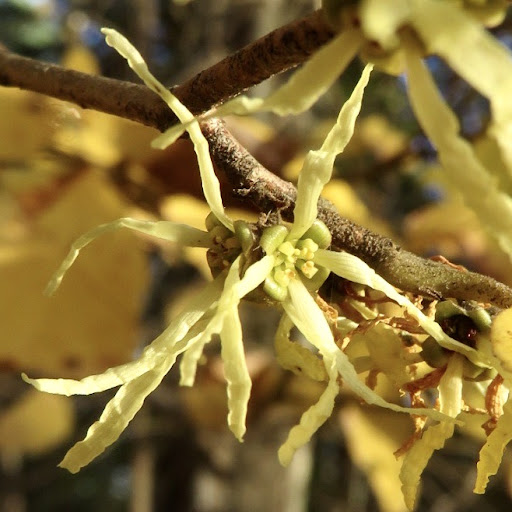
You may be wondering, “How could I have missed a shrub covered in flowers?" No doubt, the witch hazel’s bloom period defies expectations. Walkers are expecting mushrooms and colorful leaves in fall . . . and that is part of the problem. Witch hazel’s yellow flowers don’t stand out in the bright sea of autumn foliage. What’s more, the shrub’s own leaves can conceal its blossoms. Unlike the popular Asian hybrids, American witch hazel sometimes blooms while its golden leaves are still attached. The next two images illustrate the observer’s dilemma.
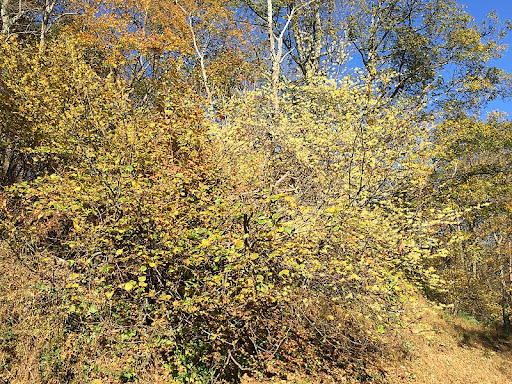
American Witch-Hazel blooming along Shenandoah National Park's Skyline Drive
Famartin, CC BY-SA 4.0
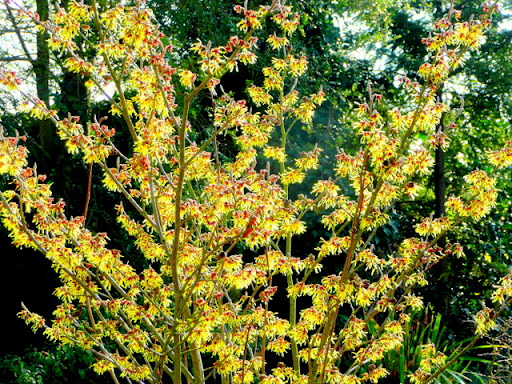
Hamamelis intermedia 'Arnold Promise'
Jonathan Billinger via Wikimedia
The American witch hazel’s flowers are lost among the fall leaves of its native deciduous forest. Whereas, the flowers of the spring-blooming hybrid have no such competition.
After the petals fall, the calyces become more noticeable. Some last through the winter and, if the flowers were pollinated, brown capsules will develop.

Witch Hazel Calyces, November 22, 2020, Hanson
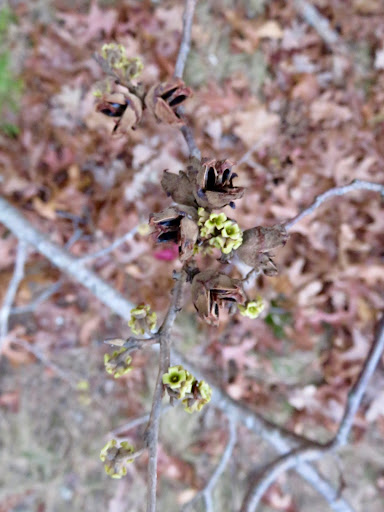
Calyces Alongside Previous Year’s Capsules
When the next autumn rolls around, the capsules will be ready to eject their seeds. Not drop or passively release, but “eject.” The Native Plant Trust uses the adverb “explosively” to describe the process. The Lady Bird Johnson Wildflower Center explains that, ”Upon drying, the contracting capsule can eject its small seed as far as 30' (9 m)” away from its parent’s shade. Be ready to listen when they pop!
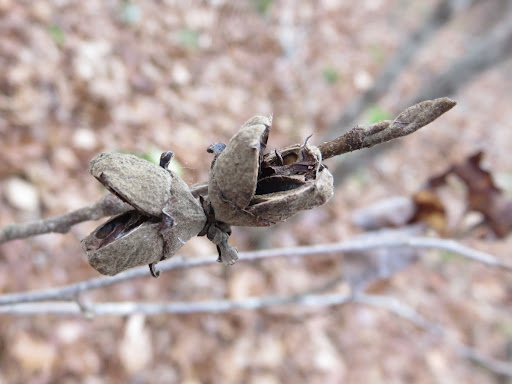
The fact that American witch hazel blooms at such an odd time raises the interesting question of who pollinates a shrub this late in the season. Unfortunately, I don’t have a definitive answer for you, though I can affirm that there is plenty of speculation. Science writers agree that pollination is accomplished by insects because witch hazel’s flowers offer all the usual enticements including showy flowers, sticky pollen, fragrance, and sugary nectar. And, despite the presumed paucity of fall insects, the list of visitors is extensive. The “Faunal Associations” section of Illinois Wildflowers includes dozens of fly and wasp families and genera that are attracted to these flowers. One extensive study found that tiny fungus gnats and small bees were the most frequent visitors, but it focused on diurnal insects. A different solution was proposed by biologist and nature writer Bernd Heinrich, one of whose specialties is insect thermoregulation. He studied night-flying winter moths who can raise their body temperature by shivering. One group of these, the sallows, are thought to pollinate witch hazel. The article, “Winter Sex: The Puzzling Case of Witchhazel” summarizes this view.
Even if you are not familiar with this shrub, I bet you have encountered witch hazel at the pharmacy or supermarket. It is hardly a new product. Native Americans and European colonists used the plant medicinally for centuries before Thomas Newton Dickinson established “the first commercial witch-hazel extract distillery” in Connecticut in 1866 (see Arnoldia – Volume 72, Issue 2). It is still used to treat inflammation and skin irritation and to reduce bleeding. The tannins, according to WebMD, “might help reduce swelling, help repair broken skin, and fight bacteria.”

Another familiar witch hazel product, Pond’s cream, had its origins as a patent medicine that was marketed as “Pond’s Extract” and “Pond’s Healing” in its early days. It was invented by “Theron T. Pond (1800–1852) of Utica, New York, in 1846. Mr. Pond extracted a healing tea from witch hazel [Hamamelis spp.] which he discovered could heal small cuts and other ailments.” Over time, the company emphasized Pond’s cosmetic value as a beauty cream and a gentle makeup removal product.
For those of you who already know this plant, my advice would be to keep looking! There is always more to observe and to learn. First off, witch hazel is still in bloom. I saw some flowers a few days ago, and you can too. If you learn to recognize the shrub’s form, you can enjoy it year round. Once the leaves have fallen, witch hazel’s distinctive terminal buds become noticeable. Unlike most tree and shrub buds, these are stalked and naked, meaning there are no protective scales to shield them from the cold. Bring a hand lens with you. That way you’ll be able to get a close look at the stellate (star-like) hairs on the young twigs and the calyces. Consider the spacing between individuals in a grove: did they sprout from seeds ejected from a granddaddy plant? And, before you head home, pay some respect to your elders. Witch hazel is a long-lived plant. Apparently, the Arnold Arboretum has a specimen that was collected in 1883 which could be close to 150 years old, most certainly older than any of us!